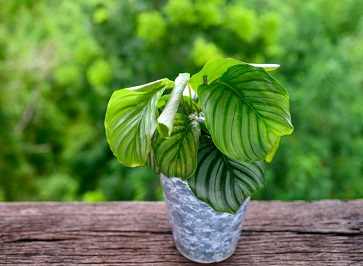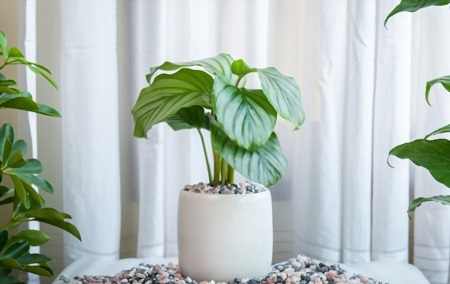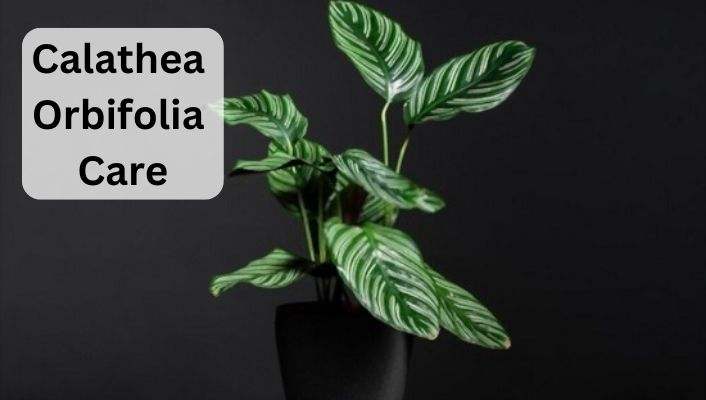Calathea Orbifolia is a beautiful houseplant. It has been demanded too much because of the exquisite beauty of its large, round leaves and its air-purifying qualities.
Their exquisite foliage is intricately striped with a combination of yellowish and silver-green markings and beautiful undersides of the same color. This color scheme gives it a unique design and is loveable by collectors.
Moreover, we think this plant will add some dramatic effects to your collection. Plus, this plant is very much on trend.
Post Contents
- Calathea Orbifolia Summary:
- Calathea Orbifolia Characteristics:
- Size and Growth:
- Calathea Orbifolia Care and Maintenance:
- Calathea Orbifolia Light Requirements:
- Watering the Calathea Orbifolia:
- Temperature Boundaries of Calathea Orbifolia:
- Humidity Requirements of the Plant:
- Best Kind of Soil:
- Fertilizing:
- Pruning:
- Repotting and Propagation:
- Frequently Asked Questions:
- Conclusion:
- Author
Calathea Orbifolia Summary:
The table below provides basic information about Calathea Orbifolia, a popular plant known for its large, round leaves and silver stripes.
| Property | Description |
|---|---|
| Scientific Name | Calathea Orbifolia |
| Common Name | Orbifolia Prayer Plant |
| Family | Marantaceae |
| Origin | South America |
| Growth Habit | Perennial |
| Light Requirement | Medium to bright indirect light |
| Watering Frequency | Moderate to high |
| Soil Type | Well-draining, fertile soil |
| Temperature | 18-24°C (65-75°F) |
| Humidity | High humidity (60-70%) |
| Height | Up to 2 feet |
| Spread | Up to 2 feet |
| Foliage Color | Green with silver patterns |
| Flowering | Infrequent, small white flowers |
| Toxicity | Non-toxic to humans and pets |
Calathea Orbifolia Characteristics:
Getting into the reason for Orbifolia’s popularity, we can see its characteristics. These plants are appreciated for their oval-shaped and broadly striking leaves.
These leaves exhibit an eye-catching green base with light green or silvery streaks. These streaks mimic the same patterns as a candy cane, making them look unique.
Besides all this, you’ll notice that this plant sometimes seems different. As a houseplant, the Orbifolia’s leaves are vivid and move throughout the day.

Size and Growth:
Calathea orbifold grows up to 3 feet tall and 2 feet wide. Amazingly it has huge leaves that grow up to 12 inches wide, making this one of the largest leafed tropical plant species. The growth rate is moderate, but it slows down during the winter.
We have gathered all the information you need to know about caring for and maintaining Calathea Orbifolia, from the basics to the complex scenarios.
Related Article: Calathea Crocata Care & Growing (Eternal Flame Plant)
Calathea Orbifolia Care and Maintenance:
Coming to the essential part of our article, we make an opening statement that Orbifolia needs moderate maintenance requirements. This plant is considered difficult to care for because its requirements (particularly for temperature and humidity) are so specific.
However, this article is just the right thing you need for both beginners and advanced plant hobbyists. This is an all-in-one guide that contains all the tips and tricks you’ll need for your plant.
Calathea Orbifolia Light Requirements:
Calathea orbifolia is part of the forest undergrowth as their natural growing habitat is in the bright forest shade. So this straight away means that you have to avoid the direct sun.
If you do not care for the correct light, your plant’s leaves will fade and get damaged. The plant also gets dehydrated quickly if kept under direct exposure to the sun.
The perfect light conditions for Orbifolia are medium or even lower light. But this doesn’t mean you have to keep them in dim conditions. They are also bad for your plant’s health. In short, this plant needs some soft light conditions.

It would help if you went for a bright room without exposure to direct sunlight. It can easily grow in a kitchen, bathroom, bedroom or wherever you desire.
We always recommend placing your plant near a window that faces north. It is ideal for these kinds of plants. You can expose them to the gentle morning sun if you are responsible.
Watering the Calathea Orbifolia:
Want to keep your Orbifolia healthy? Know that watering is the most important part of keeping your Orbifolia healthy and looking its best. As we know, tropical plants always like their soil to be evenly moist and never completely dry. The same goes for our Orbifolia.
To attain the best moisture level for your Orbifolia, check the soil and rewater when the top one or two inches of soil are almost dry. You can also protect the plant from moisture-related pests and disease, but be cautious as getting the plant too dry also has side effects. We recommend investing in a moisture meter as leaves decline without any sign.
Note: If your plant’s leaves become less vibrant or beautiful, and they are not folding at night, it sometimes indicates they need more watering.
A terracotta pot is recommended, but it quickly dries out the soil. So you always have to keep an eye out. Water it before it gets overly dried, and ensure that your pot has drainage holes because excess moisture is also dangerous.
Watering the plant thoroughly and draining the pot afterward is quite fruitful. You have to water it in depth and let the pot drain for 10 minutes or so. Doing so will flush the soil and make every part of it moist and good. Besides this, normal watering is always an option.
Always remember when keeping a Calathea orbifolia. This plant is sensitive to water salts, chlorine, and chemical build-up because of old fertilizer. It would help if you opted for filtered, distilled or purified water. You can catch bad water quality if you see leaf discoloration.
Related Post: Calathea Ornata Care Guide
Temperature Boundaries of Calathea Orbifolia:
Usually, homes have a consistent and comfortable temperature throughout. If your home environment is like this, you will have no trouble keeping the plant happy.
Calathea orbifolia requires temperatures between 65°F (18°C) to 75ºF (24ºC). This plant shows signs if the temperature is not suitable. Now, if you see the leaves begin to droop, this means the temperature is too cold. They can take a couple of degrees more than their requirement, but If the leaves start to curl, the temperature is too warm.
We recommend keeping Calathea Orbifolia away from drafts, A/C units, radiators, heating vents, and fireplaces. This plant doesn’t like sudden temperature changes, leading to leaf discoloration or loss.
Orbifolia’s leaves show signs of damage if the plant gets even a minor chill. They protest drafts and short drops below its preferred range.
If you keep your indoor Orbifolias outside in the summer, take them in before temperatures dip into the mid-50s because the cold is very dangerous to them.
Humidity Requirements of the Plant:
Moving to the humidity requirements, we have made up some points regarding it. Because it’s another key topic in this article, you can use a hygrometer to ensure the conditions. This plant needs high humidity, so here are ways to increase humidity:
- Grouping with other plants: This is a perfect and natural way of increasing humidity. Let the plants transpire, but don’t keep them too close because this will encourage sharing bugs and diseases.
- Highly Humid Place: Best humid places in our homes are bathrooms, as they are left with steam and if there is enough light for the plants, keep them there. More areas like kitchens and laundries are suitable too.
- Pebble-filled Trays: Keeping the pots above a water tray with pebbles and stones will ensure an increase in humidity levels.
- Misting Regularly: Misting your plant regularly is recommended. Use a sprayer with distilled water and mist your plant. We encourage morning mist to give plants a fresh start and a real nature-like environment.
- Humidifier: This is the best in all the points. A humidifier is expensive, but it will take your plant to full beauty as it gives a perfect humid environment.
Best Kind of Soil:
The right kind of soil is a must to keep the moisture level. A soil that drains quickly but retains some water will be the perfect one for it. The soil should have organic fertility if you want the best results.
The recommended elements of a perfect soil mix are peat or coco coir because they will hold in moisture while allowing the roots to breathe, but add enough drainage material to avoid sogginess. Moreover, perlite and pumice are good for drainage, don’t use vermiculite as it holds too much water.
Making your soil mix? You need to add two parts peat/coir and one part perlite or pumice. Orchid bark can also work for organic drainage, but it does break down over time. The ideal soil pH for Calathea Orbifolia is 6.5, and the mentioned mix will make up for it.
Organic materials are always good for making the right soil instead of inorganic and chemical-based fertilizers. Use compost for your soil, but don’t add too much as it holds water and will encourage sogginess in the soil.
Fertilizing:
Calathea Orbifolia doesn’t need too much fertilizing. Even if you want fast growth of your Orbifolia, you have to fertilize it normally. Regarding the best time to fertilize it, you can use fertilizer in the growing months or growing season, which is normally between spring and summer.
Go for a liquid houseplant fertilizer with low potassium and high nitrogen levels. Use it once a month, which will surely replenish the size and color of the vivid leaves.
Stop fertilizing your Calathea Orbifolia during the winter because the growth has slowed. If you fertilize in winter, it will burn the roots and eventually result in the death of the plant.
If the plant is not growing well, do not fertilize it. Rather look for other reasons for slowed growth (water, temperature, light, humidity). Usually over, fertilizing leads to plant death.
Pruning:
Calathea Orbifolia does not need pruning because this plant is a set of single-leaved stems. It has no branches to prune. The only maintenance you need to do is remove the brown, yellow or damaged leaves. This will ensure more growth and will not affect it.
Always use sterilized tools for this work. Wipe your tools with rubbing alcohol or any sterilizing spirit. Then you can cut near the base near the main stem. Only remove the leaves carefully, don’t cut through the main stem.
Repotting and Propagation:
It has been seen that repotting an orbifolia disturbs it. So, it’s not necessary to repot them. Some orbifolia can live in the same soil for years. But this does not mean that you shouldn’t repot them. We recommend repotting Orbifolia every 2 to 3 years.
You can do another checkup to see if it’s time to repot or not. If all the requirements are up to the mark, but the plant growth is slow, it’s time to repot it. Don’t let your plant stay rootbound for long periods.
Opt for a pot that has an 8- or 10-inch diameter. Experts always recommend this size because it is ideal for a houseplant. When repotting, keep a check on roots, don’t tear them apart. Gently loosen the soil in the roots and place them in the new soil. Afterward, pat down the soil slightly, but don’t press too hard. Keep the soil a bit fluffy.
Orbifolia should always be propagated through division. When it is time to repot plants, carefully divide the crown and root ball into two or more sections. Then report each section into its new container with fresh potting soil.
Frequently Asked Questions:
Is Calathea Orbifolia Toxic?
Calathea orbifolia is non-toxic to pets and people. Now, this does not mean that one should start eating it. It would result in an upset stomach.
Why does Calathea Orbifolia Have Brown Edges On The Leaves?
This is probably because of underwatering and low humidity.
Why is Calathea Orbifolia Drooping?
This can be a gray area. Underwatering is the primary suspect, but check for root rot beforehand
Is Calathea Orbifolia hard to care for?
You have to follow some steps that are mentioned above. These include indirect light, warm temperatures, humidity, and standard soil and watering requirements.
Should I mist Calathea Orbifolia?
Yes! Misting is a great way to interact with your plant and keep yourself busy without overwatering it. Mist it properly 2 times a week.
How do we prevent the yellowing of leaves?
Yellow leaves often indicate watering problems, such as overwatering or underwatering. Leaves will also turn yellow when the plant is stressed by temperature extremes, drafts or a recent location change. Try to fix all these problems, and you’ll see visible change.
Conclusion:
And that’s all for it. The Calathea Orbifolia is the best kind of houseplant. Only if you stick to the points, we mentioned above. We recommend getting this plant as it’s the best one out there. It is beautiful and vibrant.
Moreover, it’s really in trend these days. Be sure to take care of it, and then it’ll make sure to capture the attention of anyone who sees it in your house.
We hope you have understood all the essential points and are ready to get one of these desirable plants.
Related Articles:
Calathea Makoyana Care Guide! (Peacock Plant Care)

